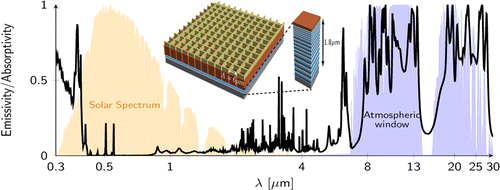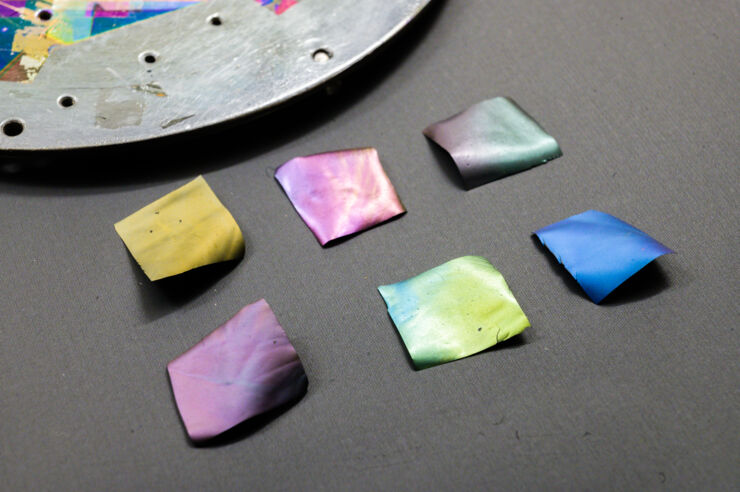
Homes and buildings chilled without air conditioners. Car interiors that don’t heat up in the summer sun. Tapping the frigid expanses of outer space to cool the planet.
Science fiction, you say? Well, maybe not any more.
A team of researchers at Stanford has designed an entirely new form of cooling structure that cools even when the sun is shining. Such a structure could vastly improve the daylight cooling of buildings, cars and other structures by reflecting sunlight back into the chilly vacuum of space. Their paper describing the device was published March 5 in Nano Letters.
“People usually see space as a source of heat from the sun, but away from the sun outer space is really a cold, cold place,” explained Shanhui Fan, professor of electrical engineering and the paper’s senior author. “We’ve developed a new type of structure that reflects the vast majority of sunlight, while at the same time it sends heat into that coldness, which cools manmade structures even in the day time.”
The trick, from an engineering standpoint, is two-fold. First, the reflector has to reflect as much of the sunlight as possible. Poor reflectors absorb too much sunlight, heating up in the process and defeating the purpose of cooling.
The second challenge is that the structure must efficiently radiate heat back into space. Thus, the structure must emit thermal radiation very efficiently within a specific wavelength range in which the atmosphere is nearly transparent. Outside this range, Earth’s atmosphere simply reflects the light back down. Most people are familiar with this phenomenon. It’s better known as the greenhouse effect—the cause of global climate change.
Two goals in one
The new structure accomplishes both goals. It is an effective a broadband mirror for solar light—it reflects most of the sunlight. It also emits thermal radiation very efficiently within the crucial wavelength range needed to escape Earth’s atmosphere.
Radiative cooling at nighttime has been studied extensively as a mitigation strategy for climate change, yet peak demand for cooling occurs in the daytime.
“No one had yet been able to surmount the challenges of daytime radiative cooling—of cooling when the sun is shining,” said Eden Rephaeli, a doctoral candidate in Fan’s lab and a co-first-author of the paper. “It’s a big hurdle.”
The Stanford team has succeeded where others have come up short by turning to nanostructured photonic materials. These materials can be engineered to enhance or suppress light reflection in certain wavelengths.
“We’ve taken a very different approach compared to previous efforts in this field,” said Aaswath Raman, a doctoral candidate in Fan’s lab and a co-first-author of the paper. “We combine the thermal emitter and solar reflector into one device, making it both higher performance and much more robust and practically relevant. In particular, we’re very excited because this design makes viable both industrial-scale and off-grid applications.”
Using engineered nanophotonic materials the team was able to strongly suppress how much heat-inducing sunlight the panel absorbs, while it radiates heat very efficiently in the key frequency range necessary to escape Earth’s atmosphere. The material is made of quartz and silicon carbide, both very weak absorbers of sunlight.
Net cooling power
The new device is capable of achieving a net cooling power in excess of 100 watts per square meter. By comparison, today’s standard 10-percent-efficient solar panels generate the about the same amount of power. That means Fan’s radiative cooling panels could theoretically be substituted on rooftops where existing solar panels feed electricity to air conditioning systems needed to cool the building.
To put it a different way, a typical one-story, single-family house with just 10% of its roof covered by radiative cooling panels could offset 35% its entire air conditioning needs during the hottest hours of the summer.
Radiative cooling has another profound advantage over all other cooling strategy such as air-conditioner. It is a passive technology. It requires no energy. It has no moving parts. It is easy to maintain. You put it on the roof or the sides of buildings and it starts working immediately.
The Latest Bing News on:
Cooling structure
- Climate change challenges cooling systems like never beforeon May 9, 2024 at 12:27 am
Kyle explained that the cooling systems common in mid and high-rise apartment buildings are frequently unable to respond to the temperature swings, leaving HVAC engineers engaged ...
- Cool Drinks And Food On The Road: Powerful Compressor Revolutionises Cooling In RV Kitchenson May 8, 2024 at 6:56 pm
With a compressor, the cooling capacity is higher, keeping the temperature in the refrigerator at stable, low levels. Thanks to additional batteries and/or photovoltaic panels, the cooling system with ...
- Don’t Let the Massive Emergence of Cicadas Bug Your Cooling Tower Performanceon May 8, 2024 at 11:00 am
With a double brood of cicadas forecasted to awaken, now is the time to prepare for how to deal with the mess they will leave behind and the potential damage they can do to equipment.
- Save $100 Off the Cooler Master NR200P MAX ITX PC Case with 280mm AIO Cooling and 850W PSUon May 8, 2024 at 10:56 am
Amazon has dropped the price on the highly rated Cooler Master NR200P MAX ITX computer case, which also includes a 280mm all-in-one liquid cooling system and 850W SFF power supply, for $301.00 shipped ...
- Cooling Solutions: Expert Car AC Repair in Dubai to Beat the Desert Heaton May 8, 2024 at 10:34 am
Dubai, a city famous for its blistering desert heat, has specific difficulties for drivers, particularly within the summer, when it comes to remaining cool. A tried-and-true car air conditioning ...
- Milk Tank Cooling System Market Surges to USD 947.1 million by 2033on May 7, 2024 at 11:11 pm
Milk tank cooling systems are the silent guardians of dairy quality, ensuring milk stays fresh from farm to table. This crucial Milk Tank Cooling System Market is experiencing steady growth driven by ...
- Mist cooling system at Raipur stn provides respite from high tempon May 3, 2024 at 4:20 pm
Passengers at Raipur station are enjoying a respite from the heat thanks to the mist cooling system implemented by the Divisional Rail Administration. The misting machines create a cool and pleasant ...
- 10 Ways To Lower Your Cooling Bill This Summer, According To Expertson May 3, 2024 at 2:15 pm
Higher temperatures usually means higher cooling bills. However, we spoke to experts and found 10 ways you can stay cool this summer without the high AC bills.
- We Tested the Eight Sleep Cooling Sleep System, Here’s How It Wenton May 2, 2024 at 11:39 am
If you’ve tried everything to keep cool throughout the night, the Eight Sleep Pod Pro Cover might just be the answer you’ve been searching for. I tried it for myself, so you know what it’s really like ...
- Vision Marine Technologies Files Second Patent for Electric Marine Vessel Cooling System Controlon May 1, 2024 at 5:06 am
BOISBRIAND, QC / ACCESSWIRE / May 1, 2024 / Vision Marine Technologies Inc. (NASDAQ:VMAR) ("Vision Marine" or the "Company"), ...
The Latest Google Headlines on:
Cooling structure
[google_news title=”” keyword=”cooling structure” num_posts=”10″ blurb_length=”0″ show_thumb=”left”] [/vc_column_text]The Latest Bing News on:
Radiative cooling
- Study informs climate resilience strategies in urban, rural areason May 8, 2024 at 8:10 am
Local decision-makers looking for ways to reduce the impact of heat waves on their communities have a valuable new capability at their disposal: a new study on vegetation resilience.
- i2Cool Attracts Close to HKD100 Million in Series A Financing to Propel the Development of Green and Energy-Efficient Radiative Cooling Solutionson May 7, 2024 at 5:00 pm
PRNewswire/ -- i2Cool, a company specializing in electricity-free cooling technology, has attracted nearly HKD100 million (USD13.8 million) in its Series A round financing from Trustar Capital (the ...
- 10 Ways To Lower Your Cooling Bill This Summer, According To Expertson May 3, 2024 at 2:15 pm
Higher temperatures usually means higher cooling bills. However, we spoke to experts and found 10 ways you can stay cool this summer without the high AC bills.
- Reducing PV module temperature with radiative cooling based on polymeric coatingson April 16, 2024 at 5:01 pm
Researchers from the King Abdulaziz University in Saudi Arabia investigated the use of polymeric coatings for passive radiative cooling (PRC) of PV modules. Radiative cooling occurs when the ...
- Enhancing radiative cooling with aperture mirror structureson April 10, 2024 at 1:59 pm
Seeking sustainable alternatives, researchers have turned to radiative cooling—a passive, zero-energy cooling method. Radiative cooling irreversibly removes heat to outer space, so from the ...
- Enhancing radiative cooling with aperture mirror structureson April 10, 2024 at 11:10 am
The aperture mirror structure enhances cooling as its geometry brings into play both the emissivity of the radiative surface and the emissivity of the atmosphere. In a world where rising ...
- Scientists reveal all-day cooling tech that also generates clean electricityon March 26, 2024 at 9:52 am
The harvester consists of a solar cell and uses radiative cooling to save more than 30 percent of electricity compared to standard solar cells. Radiative cooling is the process through which ...
- Cooling Paint You Can Actually Makeon July 3, 2023 at 9:37 am
[NightHawkInLight] has been working on radiative sky paint ... This isn’t the first time he’s demonstrated infrared cooling, but the previous demonstration used Barium Sulfate microspheres.
- Overcoming the Limitations of Traditional Power Sourceson April 18, 2023 at 5:00 pm
Simultaneously, another component called a planar radiative cooling emitter (RCE) cools part of the device by releasing heat. Image Credit: Haoyuan Cai, Jimei University Traditional power sources like ...
- Cold Tube Draws The Heaton August 27, 2020 at 7:42 pm
It uses a membrane that is permeable to infrared radiation but prevents condensation around the cooling unit. You can see a video of the apparatus in a pavilion in the Singapore heat in the video ...
The Latest Google Headlines on:
Radiative cooling
[google_news title=”” keyword=”radiative cooling” num_posts=”10″ blurb_length=”0″ show_thumb=”left”]










